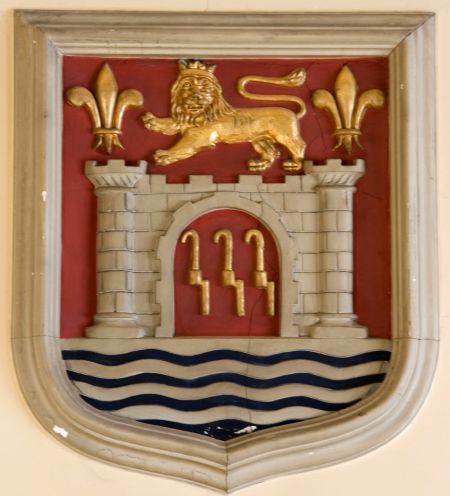Bridport: Difference between revisions
Knorrepoes (talk | contribs) No edit summary |
Knorrepoes (talk | contribs) No edit summary |
||
| Line 3: | Line 3: | ||
'''BRIDPORT''' | '''BRIDPORT''' | ||
Incorporated into : 1974 [[West Dorset]] (2019 [ | Incorporated into : 1974 [[West Dorset]] (2019 [[Dorset]]) | ||
[[File:bridport.jpg|center|Arms (crest) of {{PAGENAME}}]] | [[File:bridport.jpg|center|Arms (crest) of {{PAGENAME}}]] | ||
Revision as of 10:22, 26 March 2019
| Heraldry of the World |
| British heraldry portal Civic heraldry of the United Kingdom |
|
BRIDPORT
Incorporated into : 1974 West Dorset (2019 Dorset)
Official blazon
Arms : Gules, upon a base barry wavy of eight argent and azure, a gateway between two towers of the second, in the open port also gules three ropemakers' spinning hooks palewise in fesse Or, in chief a lion passant guardant ducally crowned between two fleur-de-lys of the last.
Origin/meaning
The arms were officially recorded at the Visitation on September 9, 1623. An earlier version was already recorded in 1565.
Bridport was already named as a borough in Domesday Book. A royal charter was received from Henry III in 1253. There were subsequent charters, the true charter of incorporation being of the year 1619. The borough arms were recorded by William Hervey, Clarenceux, on 3 October 1565; and they were "seene, approved, and allowed in our visitacon for the Countye of Dorset, the 9th day of September 1623", by Henry St. George, Richmond Herald, and Samuel Lennard, Bluemantle Pursuivant.
The shield and the gateway's open "port" — the latter has reference to the final syllable of the town's name — are coloured red. The silver gateway and the water indicate an ancient seaport.
Bridport is noted for its ancient manufactures of ropes, nets, sailcloth, etc., hence the inclusion in the design of three rope-makers' spinning cogs or hooks.
The crowned lion and the fleurs-de-lys, all of gold, are derived from the Tudor royal arms. They indicate that the arms were designed in the days of Queen Elizabeth I, because similar charges are to be found in other Elizabethan arms; those of Newark and Sudbury are examples. The lion's tongue and claws are tinctured azure.
Contact and Support
Partners:
Your logo here ?
Contact us
© since 1995, Heraldry of the World, Ralf Hartemink 
Index of the site
Literature : Image provided by Laurence Jones.












